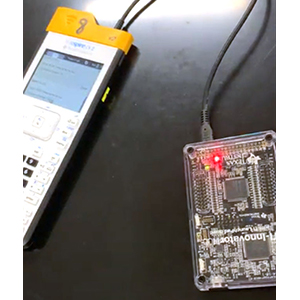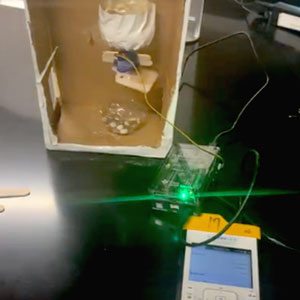Celebrate #CSEdWeek Teaching Students to Code With TI
It’s Computer Science Education Week, an annual event for partners and educators to come together and encourage students to try computer science.
In 2015, I was introduced to coding with students when I became part of an after-school organization with a team of teachers, students and professional mentors. Along with Nanoracks and Valley Christian Schools, we sent an experiment up to the International Space Station. We learned how to use a microprocessor to run our experiment — I was intrigued. How could I utilize the skills learned in this elite group of students for all of my students?
I was then introduced to the Texas Instruments TI-Innovator™ Hub with TI LaunchPad™ Board. My students were already using the TI-Nspire™ CX graphing calculator in our science classrooms for calculations, graphing, data collection and mathematical analysis of that data. What if I added some coding and programming into the classroom too? I started with TI’s 10 Minutes of Code, Units 1–5. These units teach students how to use TI-Basic as the language, and the entire process is all menu driven on the TI-Nspire™ CX graphing calculator. I started with Unit 1 during the Hour of Code challenge the next school year and continued throughout the year. My students loved it. They enjoyed the problem-solving aspect as well as seeing their hard work displayed on the handheld screen.
I then started a STEM club. This club met once a week, and we continued using TI’s 10 Minutes of Code, but added the TI-Innovator™ Hub. My students rose to the challenge with very little coding experience, as well as my limited knowledge, and we learned together. Their successful smiles and “yahoos” when they determined their errors, solved their problems and designed their own projects were contagious. As a result, I wrote several grants to purchase TI-Innovator™ Hubs, I/O and breadboard kits, as well as a few TI-Innovator™ Rovers, so that we could have an Introduction to Robotics course.
For the past two years, I have attempted some coding in my chemistry class by having students do the 10 Minutes of Code activities on Fridays. Students enjoy the break from the content as well as learning how to complete a program with very little instruction. As of now, we don’t have a computer science program at my school. So, for all of my students — between my STEM club, chemistry classes and Intro to Robotics course — this is, and was, their first introduction to coding. Very little class time was lost and, in my opinion, invaluable skills of problem-solving, teamwork and perseverance were mastered.

The students in my Introduction to Robotics course only use TI technology for their projects. We started the year with the 10 Minutes of Code units. They mastered those units and have moved on to other projects. One project was to create a traffic light using the TI-Innovator™ Hub with built-in RGB LEDs and a speaker. They also used the speaker to make music and learned how to read basic sheet music to have the TI-Innovator™ Hub play the songs.
The next project, where engineering design was introduced, was an automatic dispenser. This dispenser used the built-in TI-Innovator™ Hub brightness sensor, RGB LED lights and an input of a servo motor. Students spent one day with an introduction to engineering design and sketched their design. The next two days were spent building their designs and perfecting them. The last two days were spent with a basic shell of code that they modified for their design. Frustrations were high, and lots of challenges were met and overcome with a little patience (mostly me, 28 students in this class, lots of troubleshooting) and perseverance!

Finally, one by one, students’ designs turned into working models of an automatic dispenser. During the spring semester, I plan to introduce some of TI’s STEM Projects as well as learn how to code using Python, all on the TI-Nspire™ CX II graphing calculator.
People ask me why I teach coding/programming in the context of a STEM classroom. My response is always the same: My students — our students today — are in competition for jobs in the marketplace that don’t exist yet! We are not just content deliverers. We must look to the future and plan the context of our classrooms for what will benefit our students when they leave us. The occupational outlook for the next 10 years includes careers/jobs that all have some background in computer science skills, problem-solving, troubleshooting and teamwork. Coding and programming in a STEM classroom covers all of the skills students need to learn, and they can have fun doing it. Using TI’s 10 Minutes of Code is a time-saving, tried-and-true way to start this process in your classroom.
Happy Computer Science Week! I hope you feel inspired to try something new with your students.
About the author: Stacy Thibodeaux is a T³™ Science National Instructor. She holds a Bachelor of Science in biology and chemistry and a master’s degree in educational leadership from the University of Louisiana at Lafayette. She is currently a teacher at Southside High School in Youngsville, Louisiana, where she teaches all levels of chemistry I and II, as well as a newly created Introduction to Robotics course. Thibodeaux uses TI technology to assist her teaching, robotics course implementation, data collection, and modeling of math concepts, linking them to science content. Follow Stacy on Twitter @stacythib.
Tagcloud
Archive
- 2025
- 2024
- 2023
- 2022
-
2021
- January (2)
- February (3)
- March (5)
-
April (7)
- Top Tips for Tackling the SAT® with the TI-84 Plus CE
- Monday Night Calculus With Steve Kokoska and Tom Dick
- Which TI Calculator for the SAT® and Why?
- Top Tips From a Math Teacher for Taking the Online AP® Exam
- Celebrate National Robotics Week With Supervised Teardowns
- How To Use the TI-84 Plus Family of Graphing Calculators To Succeed on the ACT®
- AP® Statistics: 6 Math Functions You Must Know for the TI-84 Plus
- May (1)
- June (3)
- July (2)
- August (5)
- September (2)
-
October (4)
- Transformation Graphing — the Families of Functions Modular Video Series to the Rescue!
- Top 3 Halloween-Themed Classroom Activities
- In Honor of National Chemistry Week, 5 “Organic” Ways to Incorporate TI Technology Into Chemistry Class
- 5 Spook-tacular Ways to Bring the Halloween “Spirits” Into Your Classroom
- November (4)
- December (1)
-
2020
- January (2)
- February (1)
- March (3)
- April (1)
- May (2)
- July (1)
- August (2)
- September (3)
-
October (7)
- Tips for Teachers in the time of COVID-19
- Top 10 Features of TI-84 Plus for Taking the ACT®
- TI Codes Contest Winners Revealed
- Best of Chemistry Activities for the Fall Semester
- Best of Biology Activities for the Fall Semester
- Best of Physics Activities for the Fall Semester
- Best of Middle Grades Science Activities
- November (1)
- December (2)
- 2019
-
2018
- January (1)
- February (5)
- March (4)
- April (5)
- May (4)
- June (4)
- July (4)
- August (4)
- September (5)
-
October (9)
- Art in Chemistry
- Which Texas Instruments (TI) Calculator for the ACT® and Why?
- Meet TI Teacher of the Month: Jessica Kohout
- Innovation in Biology
- Learning With Your Students
- A first-of-its-kind STEM strategy charts path to help educators
- #NCTMregionals Hartford 2018 Recap
- The Math Behind “Going Viral”
- Real-World Applications of Chemistry
-
November (8)
- Testing Tips: Using Calculators on Class Assessments
- Girls in STEM: A Personal Perspective
- 5 Teachers You Should Be Following on Instagram Right Now
- Meet TI Teacher of the Month: Katie England
- End-of-Marking Period Feedback Is a Two-Way Street
- #NCTMregionals Kansas City 2018 Recap
- Slope: It Shouldn’t Just Be a Formula
- Hit a high note exploring the math behind music
- December (5)
- 2017
- 2016
- 2015
